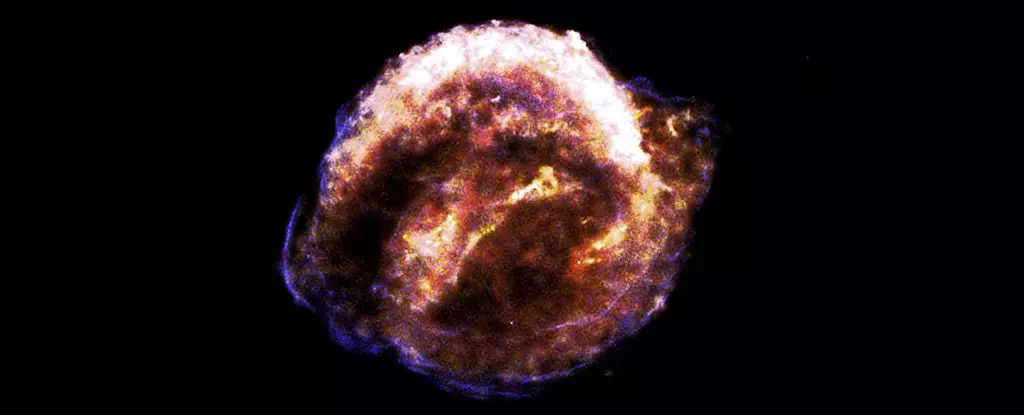The universe is an intricate tapestry woven from the threads of celestial events, among which supernovae stand out as some of the most powerful. These cataclysmic explosions associated with massive stars release an immense amount of energy, play critical roles in cosmic evolution, and are responsible for creating metals heavier than hydrogen and helium. Among these heavy elements, iron is created in abundance and flung into space, forming an essential component in the cosmic cycle of material. Researchers are starting to uncover how these stellar events, particularly those occurring millions of years ago, have played a vital role in shaping the conditions on Earth, including the evolution of life itself.
The Heavy Element Legacy: Iron and the Earthly Record
Recent studies have examined ancient deposits of the iron isotope Fe60 found in oceanic sediments, providing a crucial link between the cosmic explosions and life on Earth. Peaks in Fe60 concentrations can be traced back approximately two to three million years ago and five to six million years ago. The research conducted by Caitlyn Nojiri and colleagues posits that these peaks correlate with supernova events, contributing to our understanding of the relationship between cosmic phenomena and biological evolution. The relevance of these isotopes cannot be overstated, as Fe60 serves as evidence of supernova activity and its downstream effects on Earth’s environment.
At the heart of this discourse is our proximity to a unique cosmic structure known as the Local Bubble. This large area of hot, rarefied gas is created by the outflows from massive stars, characterized by intense stellar winds. Formed over millions of years through multiple supernovae, the Local Bubble envelops our Solar System, and entering it approximately five to six million years ago helped explain the older isotopic accumulation of Fe60. Such stellar phenomena do not merely exist; they actively influence their surroundings, including the cosmic radiation to which Earth is exposed. This raises intriguing questions about how environmental shifts, initiated by distant cosmic events, can lead to substantial biological repercussions on Earth.
The discussion of cosmic radiation is critical when assessing its potential impacts on biological systems. Supernovae and the accompanying bursts of ionizing radiation introduce layers of complexity concerning the evolution of life. The research highlights that the radiation stemming from these cosmic events can dramatically elevate radiation levels on Earth, potentially shaping evolutionary trajectories. Historical data supports the possibility of increased mutation rates correlating with increased radiation—an essential factor in the diversification of species. Findings highlighting accelerated virus diversification in Lake Tanganyika suggest that cosmic radiation might represent a significant environmental factor influencing life’s evolutionary mechanisms.
The Dark Side of Radiation: Potential Cellular Damage
While some mutations can fuel adaptive evolution, radiation also entails risk. According to the research, high doses of radiation from supernovae could inflict double-strand breaks in DNA. Such genetic damage is not merely trivial; it can lead to severe consequences, including cell death and chromosomal abnormalities. The balance between radiation as a catalyst for diversity and a source of potential harm forms crucial ground for scientists investigating the evolutionary narrative of life on Earth. Understanding this dichotomy is vital, as it underscores the importance of both environmental influences and inherent biological resilience in shaping evolutionary outcomes.
Despite the evident connections suggested in the research, several questions linger. The exact thresholds for radiation exposure—those points where cosmic radiation becomes beneficial or detrimental—remain poorly understood. The conditions under which cosmic radiation becomes a favorable factor for evolution require further exploration, particularly as it pertains to the effects of specific radiation types like muons, which dominate at ground level. As we continue to scrutinize the profound impacts of supernovae on our planet, it becomes clear that unraveling these mysteries could open new avenues in our understanding of life’s intricate dance with the cosmos.
In summation, the study of supernovae and their influence on Earth paints a compelling picture of the interplay between cosmic events and biological evolution. These stellar phenomena may have catalyzed pivotal moments in life’s history, ushering in waves of diversification and adaptation. As we contemplate our planet’s journey within the cosmos, it is evident that supernovae are far more than mere cosmic fireworks; they are integral threads in the fabric of Earth’s evolutionary narrative. The exploration of environmental influences on life continues to emphasize the significance of cosmic radiation, offering a reminder that we are more connected to the universe than we often perceive.


Leave a Reply